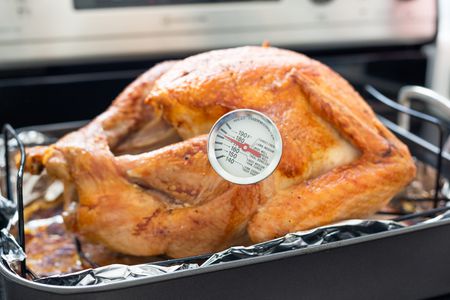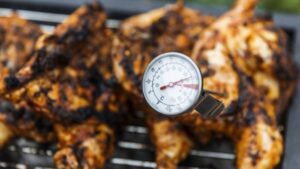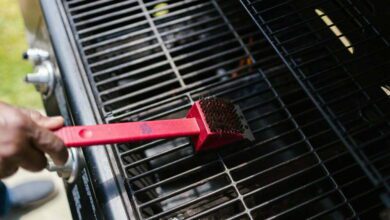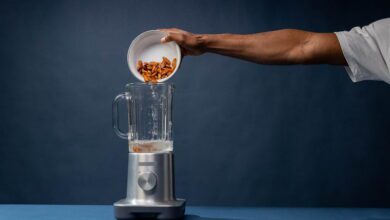
When Cooking Ground Beef, Use Food Thermometer
(NC)-According to Health Canada, colour is not a reputable sign that hamburger has actually been prepared to the temperature level required to damage damaging germs such as E. coli O157: H7.
The only means to ensure a burger patty is prepared effectively as well as securely is to make use of an instant-read food thermostat.
Researches reveal that the colour of prepared hamburger patties can differ significantly. At 71 ° C( 160 ° F)a securely prepared patty might look brownish, pink or some variant of pink or brownish.

The lower line is that if you prepare your hamburger to 71 ° C( 160 ° F)as well as examine it with an instant-read food thermostat, you can appreciate a risk-free, succulent hamburger.
To promptly as well as quickly examine the temperature level of the hamburgers, simply get rid of the patties from the warm resource when they are nearly done as well as place an instant-read food thermostat sidewards right into the centre of the thickest hamburger.
If the temperature level signs up at the very least 71ºC (160ºF), the hamburger is done, otherwise, proceed food preparation up until a minimum temperature level of 71ºC (160ºF) is gotten to.

Wellness Canada additionally recommends that customers do not consume burger patties that are red or pink between, unless a food thermostat has actually been utilized to confirm the correct temperature level has actually been attained.
This is particularly crucial for individuals most in jeopardy for foodborne disease because E. coli O157: H7, a germs that can be existing in hamburger, can cause major health problem or perhaps fatality.
Those most in jeopardy consist of kids, the senior, expectant ladies and also individuals whose body immune systems have actually been deteriorated by cancer cells, kidney condition and also various other persistent diseases.
To find out more on food safety and security, check out the Canadian Partnership for Consumer Food Safety Education Web website at www.canfightbac.org.
Do You Know Where Your Food Thermometer Is?
(NC)-Consumers have long been advised to use food thermometers to measure the internal temperature of foods, such as meat and poultry,
to verify that a safe temperature is reached and that harmful bacteria like Salmonella and E. coli O157:H7 are destroyed.
There are many good reasons to use a food thermometer. Food thermometers help you to:
cook food to a safe temperature
prevent overcooking and get the best flavour
take the guesswork out of cooking
During this barbecue season, remember to use an instant-read food thermometer every time you prepare beef patties. Health Canada recommends cooking ground beef to a minimum internal temperature of 71°C (160°F).
Insert a probe-type instant-read thermometer through the side of the beef patty until the tip reaches the centre. Fork-style temperature devices can be inserted through the top into the centre of the patty.
For more information on food safety, visit the Canadian Partnership for Consumer Food Safety Education Web site at www.canfightbac.org.
Hot Enough For You? Only The Thermometer Knows
(NC)-When it comes to preparing ground beef, it’s not easy to tell if it’s properly cooked. Many people guess that their burgers are done when they’re brown.
However, ground beef can turn brown before disease-causing bacteria, such as E. coli O157:H7, are killed.
Canada’s food is among the safest in the world, but bacteria are everywhere, including in ground beef. If food isn’t handled safely, harmful bacteria can multiply to dangerous levels and make you sick.
According to Health Canada, using a food thermometer is the best way to ensure that food has reached a temperature high enough to destroy harmful bacteria.
Thanks to new technologies, food thermometers are now easier than ever to use, even in thin foods like hamburgers.
Food thermometers are available in lots of different shapes and sizes -disposables, pop-ups, digitals, dials-even in the tips of barbecue forks! However, not all types are appropriate for testing beef patties.
Use a suitable temperature measuring device, such as a single-use temperature indicator, an instant-read fork-style thermometer, or an instant-read digital thermometer inserted in the centre of the beef patty to measure its internal temperature.
For a tasty, safely-cooked burger, the internal temperature must be 71°C (160°F).
For more information on food safety, visit the Canadian Partnership for Consumer Food Safety Education Web site at www.canfightbac.org.
Food Safety Tips For Barbecuing
(NC)-When barbecuing, use the following tips from Health Canada to safely prepare, cook, serve and store ground beef:
Before cooking
Wash hands thoroughly, for at least 20 seconds, with warm water and soap, before and after handling raw meat.
Clean and sanitize all utensils and work surfaces with soap and water after preparing each food item and before you move on to the next food.
For added protection, sanitize utensils and counter surfaces with a mild bleach solution of 5 ml (1 tsp) bleach to 750 mL (3 cups) of water.
Use different utensils for raw and cooked meat or thoroughly wash them between uses. This includes flipping spatulas, tongs, food thermometers, plates, trays, etc.
Ensure the gas barbecue is pre-heated before starting to cook. If using a charcoal barbecue, use enough charcoal and make sure it is glowing red before starting to cook.
Keep raw meat away from cooked meat; do not use the same plate to carry burgers to and from the barbecue. Keep salads and perishable foods in the refrigerator until you are ready to serve them.
If food is being stored in a cooler, pack the cooler with ice or freezer packs. Keep lid closed as much as possible, store cooler in shade and away from birds and animals.
During cooking
Use a food thermometer to ensure that the hamburger has reached a safe internal temperature. All ground beef products should be cooked to 71°C (160°F).
Insert a probe-type instant-read thermometer through the side of the beef patty until the tip reaches the centre. Fork -style thermometers can be inserted through the top into the centre of the patty.
Reduce the heat of the gas barbecue or raise the height of the charcoal grill if food starts to burn during cooking, but ensure that correct internal temperature is still met. Remember that colour is not an indicator that the patty is safe to eat.
After cooking
Keep serving bowls covered.
Put cooked food on a clean plate.
Eat food as soon as it is ready.
Clean and sanitize all utensils and work surfaces.
Store leftovers within 2 hours in separate shallow, covered containers in the refrigerator and eat within 3 days. Reheat leftovers to 74°C (165°F), using a food thermometer to check the temperature.
For more information on food safety, visit the Canadian Partnership for Consumer Food Safety Education Web site at www.canfightbac.org.
Cooked Foods on a Raw Diet
Does moving to a raw foods diet mean never eating hot food again? No, it doesn’t. Sometimes you want something hot.
Hot food has always signified comfort for many of us. And on a cold, rainy day, carrot sticks or wheatgrass juice probably won’t cut it for most of us.
Most raw food, like our bodies, is very perishable. When raw foods are exposed to temperatures above 118 degrees, they start to rapidly break down, just as our bodies would if we had a fever that high.
One of the constituents of foods which can break down are enzymes. Enzymes help us digest our food.
Enzymes are proteins though, and they have a very specific 3-dimensional structure in space. Once they are heated much above 118 degrees, this structure can change.
Once enzymes are exposed to heat, they are no longer able to provide the function for which they were designed.
Cooked foods contribute to chronic illness, because their enzyme content is damaged and thus requires us to make our own enzymes to process the food.
The digestion of cooked food uses valuable metabolic enzymes in order to help digest your food. Digestion of cooked food demands much more energy than the digestion of raw food.
In general, raw food is so much more easily digested that it passes through the digestive tract in 1/2 to 1/3 of the time it takes for cooked food.
Eating enzyme-dead foods places a burden on your pancreas and other organs and overworks them, which eventually exhausts these organs.
Many people gradually impair their pancreas and progressively lose the ability to digest their food after a lifetime of ingesting processed foods.
But you certainly can steam and blanch foods if you want your food at least warm.
Use a food thermometer and cook them no higher than 118 degrees Fahrenheit. Up to this temperature, you won’t be doing too much damage to the enzymes in food.
Wholesome Kosher Food Means Quality Family Meals
With the fast-paced schedules most families face these days, mealtime is one of the most important times for bringing families together.
Just as important as making quality time to eat with your kids, however, is making sure they are eating quality food that is good for them.
Topping the list of easy and popular meals to enjoy with your kids is-you guessed it-hot dogs.
In fact, a recent poll showed that hot dogs remain kids’ number-one food choice while enjoying outdoor activities. However, even the biggest hot dog lovers aren’t always sure exactly what it is that they’re eating.
The kosher symbol-represented as a triangle with a “K” inside it on packaging, such as on Hebrew National Franks-eliminates that doubt. The kosher seal is proof that there are no mystery meats or surprise ingredients.
In fact, recent studies show that more than nine out of 10 Americans consider trusted seals such as kosher, organic and whole grain when shopping for good food for their family.
The rising appeal of organic foods in particular is the result of moms seeking out the highest-quality ingredients for their families, and many are choosing kosher foods for similar reasons.
Kosher foods provide an assurance of quality and purity of ingredients similar to what you’ll find in your favorite organic foods.
For thousands of years, food prepared under kosher supervision has been a guarantee of the purity and cleanliness of that food.
When it comes to ingredients and hot dogs, the word “beef” in particular can mean lots of things, including meat from sources you might not immediately think of.
What you can expect from choosing kosher franks such as Hebrew National is 100 percent kosher beef, made from only the finest cuts of beef, without artificial flavors, colors, fillers and by-products.
The kosher symbol certifies both high-quality ingredients and clean preparation processes that meet strict kosher standards.
And Hebrew National’s century of experience producing only kosher foods means it’s a name you can trust, especially when you’re looking to feed quality, great-tasting food to your kids.
Glazed Frank Kabobs
Grilling spray
1/2 cup chili sauce
3 tablespoons brown sugar
2 tablespoons Hebrew National® Deli Mustard
1 package (16 ounces) Hebrew National Dinner Beef Franks, cut into 16 (11/2-inch) pieces
1 small red onion, cut into 1/2-inch wedges
1 medium red bell pepper, cut into 1-inch pieces
1 medium green bell pepper, cut into 1-inch pieces
2 medium ears fresh corn, shucked, cut into 1-inch-thick slices
Spray cold grate of outdoor grill with grilling spray. Prepare grill for medium heat. Combine chili sauce, brown sugar and mustard in small bowl until blended.
Set aside. Thread franks and vegetables alternately on 4 metal or heavy wooden skewers. Place kabobs on grill.
Brush with half of the sauce; grill 5 minutes. Turn kabobs; brush with remaining sauce. Grill 5 minutes or until vegetables are tender and franks are hot.
Food Safety 101
(NC)—Bagged lunches are healthy, economical and nutritious. But they also pose the threat of hosting harmful bacteria, unless food is handled and packed properly.
Use the following tips as your study guide for “Food Safety 101″:
• Spill-proof, seal-able bags are a must for transporting and storing food safely. Stock up on these items to keep leftovers ready for the lunch box.
• Preparing lunch the night before is a great time-saver. Store lunches safely in the refrigerator overnight.
• Prepare a clean surface for lunch packing. Wash your hands, utensils and counter with hot, soapy water to destroy bacteria.
• Sandwiches are a popular lunchtime staple: look for lunchmeat with a reputable brand name to ensure food safety.
Maple Leaf, for instance, has made food safety a top priority and is committed to providing customers with the highest standards of food safety assurance.
• Consider using an insulated travel bottle. It will keep leftover soup, chili or stew safe and hot until you’re ready to enjoy it.
• Look for a freezer gel pack and an insulated lunch box. These items will keep foods like sandwiches cool until lunchtime, preventing bacterial growth.
• Store your lunch in a refrigerator at work or school, if possible. If not, avoid leaving your lunch in direct sunlight or near any heat source.
Congratulations, you are now a “Food Safety 101″ graduate.
You are certified to pack safe bagged lunches, and to teach your favourite students about the importance of food safety. For graduate-level food safety tips, visit www.mapleleaf.com.
– News Canada
Perfect Picnics – Frugal Food Safety Tips
Summer is finally here and for a lot of us that means heading out to the lake or to the park for a picnic with friends or family.
Unfortunately, if we’re not careful when we plan, transport and serve that picnic, our outing might not end up happily.
Here are some tips to remember when planning an outdoor meal:
1. Keep hot foods hot and cold foods cold. Bacteria multiply quickly at temperatures between 40 and 140 degrees. Foods that have been kept at unsafe temperatures are a prime source of foodborne illnesses.
2. Plan ahead and try to take foods that don’t spoil so quickly. At any rate, don’t eat anything that’s been sitting out for more than an hour, especially if the temperature is over 80.
3. Try to take only the amount of food that will be eaten, so there will be no leftovers.
4. Pack your food with ice or cold packs in an insulated cooler.
Place foods that will be eaten last in the bottom. You can make your own blocks of ice by freezing water in milk cartons or other plastic containers.
Place ice blocks or cold packs between containers of food, never just place containers of food on top of ice.
5. You might want to bring 2 coolers — 1 for drinks, because it will be opened more often, and 1 for the food, that can be set in the shade and kept closed until needed.
6. If you’re planning to cook hamburgers at the picnic site, shape your meat into patties and freeze before putting into the cooler. Take along a meat thermometer to be sure you cook the meat to an internal temperature of at least 160 degrees.
7. An extra zip-top bag full of ice can be placed in the top of the cooler. The extra ice will come in handy for the trip home. If your day is a long one, and the ice melts the cold water can come in handy, also.
8. Carry your cooler inside your car, instead of in your hot trunk and be sure to place it in a shady spot and maybe even cover it with a blanket when you reach your destination. Open it only when necessary.
9. Instead of bringing whole jars of condiments, pack what you will need into smaller plastic containers.
10. Bring lots of clean utensils for serving as well as eating. Pack pre-moistened towelettes and paper towels for easy cleanup.
11. And remember this rule from the U.S. Department of Agriculture regarding leftovers: When in doubt, throw it out!
what temperature to cook ground beef on stove,how to cook ground beef,how to cook ground beef so its tender,how long to cook ground beef,
what temperature to cook ground beef in oven,ground beef temperature,what temp to cook ground beef in oven,ground beef should be cooked to,






